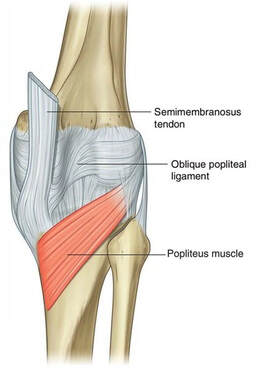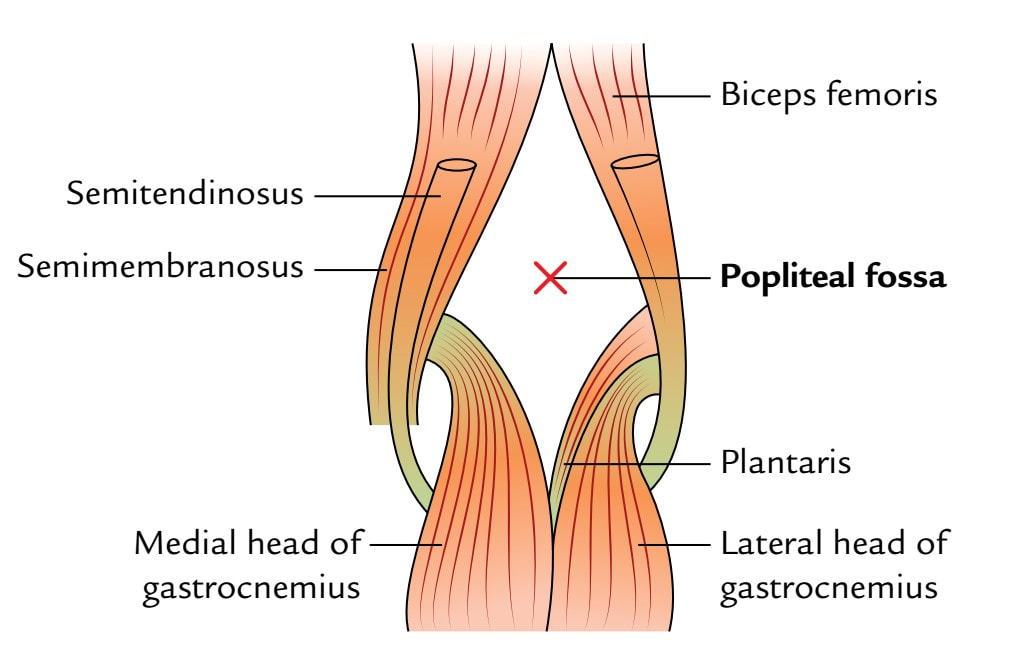|
The Popliteus muscle is a small triangular muscle that lives right behind the knee. This super small and super cool muscle seems to have two important functions. It assists in knee flexion and internal rotation of the lower leg. Sounds like an important job considering how many people have knee problems, and it’s a shame that this thin, flat muscle doesn’t get the fame and attention it deserves! Well I am here to change that, so let me tell you how cool this muscle really is… Let’s start with where Popliteus hangs out. The popliteus is located near what is called the popliteal space. According to earthslab.com, “Popliteal Fossa is a diamond-shaped hollow found on the rear side of the knee joint. When the knee is bent it becomes relevant. As it gives passage for primary vessels and nerves from the thigh to the leg, this fossa has great anatomical significance.”  Now that you are familiar with the popliteal fossa, let’s take a closer look at the popliteus muscle. This short bellied muscle can have a huge impact on the stability of the knee joint. The popliteal tendon crosses behind the knee superficially (closer to the skin) and passes the lateral meniscus, as it then moves diagonally and downward to attach at the tibia. It is said to be the only muscle behind the knee that does not directly act on the ankle. Although it may not directly act on the ankle joint, it might impact the surrounding joints indirectly. How does it do that you ask? The popliteus’ action or inaction and it’s connection with the lateral aspect of the meniscus, the oblique popliteal ligament, the medial and lateral collateral ligaments (responsible for side to side stability of the knee), as well as the anterior and posterior cruciate ligaments (responsible for front to back stability), can impact knee joint stability. When these ligaments are out of balance, the knee is out of balance. They are like myofascial family and one can really impact the other strongly! Within the human body, when one joint is out of balance it indirectly impacts the joints above and below it (hip joint, ankle joint). To complicate the effect even further, due to biotensegrity within the body, every other joint is subtly shifted and impacts the shape and function of all the other joints in the human body. So, what can you do to improve your popliteal function? Let’s start with a way to release a tight popliteus. Start out in a kneeling position and place a Yoga Tune Up® therapy ball behind your knee on the lower leg. Begin to slowly sit back to increase the pressure of the therapy ball to your desired level of intensity. You can also start to cross fiber by moving your hips to the right and left while continuing the pressure of the ball behind the knee. Try to imagine the deep popliteus muscle connecting with the ball and releasing once you release the ball. There are also some yoga poses that explore the popliteal function. For example, marching from Tadasana, mountain pose to chair, triangle pose to warrior 2 and Yoga Tune up® Warrior 3 squats! Give them a try, focus on your knees and notice the deep popliteus muscle initiating knee flexion and stabilizing the knee as you move from one pose to the next. There is so much more to learn explore around the knee joint so this is only the beginning, but for now just enjoy how ‘fossa” nating the popliteal fossa and muscle really is! References: The role of the oblique popliteal ligament and other structures in preventing knee hyperextension. Popliteus, the Tiny Muscle of Knee Pain, https://neurokinetictherapy.com/2012/04/22/the-popliteus-the-tiny-muscle-of-knee-pain/ Anatomy, Bony Pelvis and Lower Limb, Popliteal Region Hyland S, Varacallo M. https://www.ncbi.nlm.nih.gov/books/NBK532891/ [image of popliteal fossa retrieved from https://www.earthslab.com/anatomy/popliteal-fossa/]
1 Comment
|
meLanie haleSome thoughts just need to get out of my head or they will be stuck in my mind forever. Archives |
